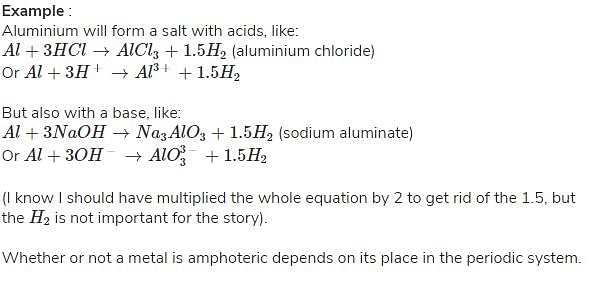Class 7 Exam > Class 7 Questions > How base react with metal?
Start Learning for Free
How base react with metal?
Verified Answer
How base react with metal?
Most metals will not react with bases. But others, called amphoteric metals, may form salts with them.

 This question is part of UPSC exam. View all Class 7 courses
This question is part of UPSC exam. View all Class 7 courses
Most Upvoted Answer
How base react with metal?
Interaction of Bases with Metals
Metallic elements react differently with bases depending on their reactivity. Here is a detailed explanation of how bases react with metals:
Alkali Metals (Group 1)
- Alkali metals, such as sodium and potassium, react vigorously with bases to form ionic salts.
- The reaction typically involves the metal displacing hydrogen from the hydroxide ion in the base, resulting in the formation of a metal hydroxide and hydrogen gas.
- For example, when sodium reacts with a base like sodium hydroxide, it forms sodium hydroxide and hydrogen gas.
Alkaline Earth Metals (Group 2)
- Alkaline earth metals, such as calcium and magnesium, also react with bases to form metal hydroxides.
- The reaction is less vigorous compared to alkali metals, but still produces metal hydroxides and hydrogen gas.
- For example, when calcium reacts with a base like calcium hydroxide, it forms calcium hydroxide and hydrogen gas.
Transition Metals
- Transition metals do not react with bases as readily as alkali and alkaline earth metals.
- Some transition metals may form insoluble metal hydroxides when reacted with bases, but the reactions are usually slow and limited.
- For example, iron can react with bases to form iron hydroxide, which may precipitate out of solution.
In conclusion, the reaction of bases with metals results in the formation of metal hydroxides and hydrogen gas, with the reactivity of the metal determining the extent and speed of the reaction.
Metallic elements react differently with bases depending on their reactivity. Here is a detailed explanation of how bases react with metals:
Alkali Metals (Group 1)
- Alkali metals, such as sodium and potassium, react vigorously with bases to form ionic salts.
- The reaction typically involves the metal displacing hydrogen from the hydroxide ion in the base, resulting in the formation of a metal hydroxide and hydrogen gas.
- For example, when sodium reacts with a base like sodium hydroxide, it forms sodium hydroxide and hydrogen gas.
Alkaline Earth Metals (Group 2)
- Alkaline earth metals, such as calcium and magnesium, also react with bases to form metal hydroxides.
- The reaction is less vigorous compared to alkali metals, but still produces metal hydroxides and hydrogen gas.
- For example, when calcium reacts with a base like calcium hydroxide, it forms calcium hydroxide and hydrogen gas.
Transition Metals
- Transition metals do not react with bases as readily as alkali and alkaline earth metals.
- Some transition metals may form insoluble metal hydroxides when reacted with bases, but the reactions are usually slow and limited.
- For example, iron can react with bases to form iron hydroxide, which may precipitate out of solution.
In conclusion, the reaction of bases with metals results in the formation of metal hydroxides and hydrogen gas, with the reactivity of the metal determining the extent and speed of the reaction.
Attention Class 7 Students!
To make sure you are not studying endlessly, EduRev has designed Class 7 study material, with Structured Courses, Videos, & Test Series. Plus get personalized analysis, doubt solving and improvement plans to achieve a great score in Class 7.

|
Explore Courses for Class 7 exam
|

|
How base react with metal?
Question Description
How base react with metal? for Class 7 2024 is part of Class 7 preparation. The Question and answers have been prepared according to the Class 7 exam syllabus. Information about How base react with metal? covers all topics & solutions for Class 7 2024 Exam. Find important definitions, questions, meanings, examples, exercises and tests below for How base react with metal?.
How base react with metal? for Class 7 2024 is part of Class 7 preparation. The Question and answers have been prepared according to the Class 7 exam syllabus. Information about How base react with metal? covers all topics & solutions for Class 7 2024 Exam. Find important definitions, questions, meanings, examples, exercises and tests below for How base react with metal?.
Solutions for How base react with metal? in English & in Hindi are available as part of our courses for Class 7.
Download more important topics, notes, lectures and mock test series for Class 7 Exam by signing up for free.
Here you can find the meaning of How base react with metal? defined & explained in the simplest way possible. Besides giving the explanation of
How base react with metal?, a detailed solution for How base react with metal? has been provided alongside types of How base react with metal? theory, EduRev gives you an
ample number of questions to practice How base react with metal? tests, examples and also practice Class 7 tests.

|
Explore Courses for Class 7 exam
|

|
Suggested Free Tests
Signup for Free!
Signup to see your scores go up within 7 days! Learn & Practice with 1000+ FREE Notes, Videos & Tests.























